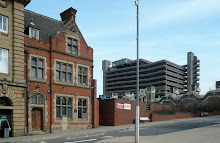
Mon 03 Nov 2008 - Sat 22 Nov 2008
The Fishmarket is proud to welcome artists selected by Workplace Gallery in Gateshead for a special group show.
TANYA AXFORD Hula Hoops incessantly in a pitch-black room. Randomly exposed by oversensitive ‘slave’ camera flashes triggered by an intermittently firing strobe she circumnavigates performance, photography and sculpture.
Well known for his eclectic use of material ERIC BAINBRIDGE has spent his career reconsidering modernism. In Untitled 2008 Sausages and Melamine combine to revel in their own redundancy – visually heroic yet utterly futile.
Old TV sets play DARREN BANKS' re-cut videos from found movies in which Public Sculpture and Armageddon emerge as dominant themes for the present.
Christina Is Not Well after a heavy night out In Sunderland in SOPHIE LISA BERESFORD'S film, which inadvertently explores biography, social commentary and visceral sculptural presence to loud effect.
Human presence is the basis of CATHERINE BERTOLA'S archaeologies. In Flights of Fancy she re-inhabits found C19th glass photographs, posing as a middle class Lady in a Victorian interior.
CATH CAMPBELL presents the interior and exterior space of architecture as one through her intricate perspective drawings on paper that move from object to image to object again via her precise cutting away with a scalpel.
HUGO CANOILAS' arrangement of found and painted objects combines figuration, abstraction and political symbolism to resurrect the energy and ideology of the original avant-garde.
JOE CLARK'S film Gateshead Light Sequence features the humble street lamp shifting through degrees of luminescent intensity via an animated sequence of still photographs at night.
In 'Cadences' MARCUS COATES takes the last bars at the end of pastoral symphonies to construct a new audio landscape.
JO COUPE'S centrifugally cast bronze works fuse high precision jewellery techniques with botanical expertise to explore a complex relationship between beauty and decay.
JENNIFER DOUGLAS brings together carefully selected materials to create a discourse between the material world in which the work exists, and the imagined worlds that form the basis for her sculpture.
ASHLEY HIPKIN'S sculptures examine the memory and ethics of function and use through the combination of reconstructed objects from the past cut up, replicated, reformed and painted with the obsolete colours of yesterday.
Like a Polaroid fading into focus the identities of the subjects of LAURA LANCASTER'S paintings are never clear. This state of flux and fluidity allows the works to exist in a temporal, ambiguous space reaffirming the anonymity of the found photographs that she works from.
RACHEL LANCASTER takes photographs of seemingly insignificant passing shots from ‘cult’ films and television programmes. Her paintings from these photographs interrogate the seemingly unimportant moments of a greater narrative - a blurred portrayal of a corridor from Teenwolf or a car bonnet from The Sopranos. Divorced physically from the story her paintings maintain a mysterious connection with ‘the event’ and a cinematic monumentality.
ANT MACARI'S drawings function at once as a schematic, developmental process and constitute the resolution of ideas themselves. Through drawing and writing he communicates a tacit understanding of the culture that has made him.
PAUL MERRICK combines painting with sculpture, and the made with the ready-made. Investigating colour, shape and architectural arrangement whilst consistently referencing back to Painting as a subject and discipline in and of itself.
PAUL MOSS' work responds to the particularity of the urban environment by conflating hand-made processes with manufactured materials to form motifs that reference the information culture that we live in and also pure abstraction and modularity.
GINNY REED'S photographs are residues and remnants of performance events. Party Hard is incidental, monumental and autobiographical in the same moment, finding a new position between documentation and the authoritative image.
RICHARD RIGG'S work resonates within its own solipsistic self-referentiality. The work is its own context. Object, function and aesthetics combine to find a reductive equilibrium through which he re-examines the minimal strategy in art, moving its flawed logic towards an aesthetic endgame.
Using herself as a template for the individual and challenging the notion of self in today’s media-obsessed society through mediated mainstream reportage
CECILIA STENBOM presents the ideal of the perfect person as an unachievable but self consciously striven-for entity.
MILES THURLOW'S work is deliberately paradoxical - at once conceptually sophisticated and aesthetically bare. Referencing the demise of modernism and the rise of quick fix, cheap alternatives his work investigates the architecture of modern day living and our relationship with the products of consumer culture.
WOLFGANG WEILEDER'S long exposure photographs are of the sculptural rebuilding of specific houses and architecture. Constructed and deconstructed one façade at a time Weileder’s architectures are displaced and isolated through location, labour and time. These ephemeral, time based events become translucent images of urban regeneration portraying haunting civic visions of a possible future.
Image "It's Not The End Of The World", Darren Banks, 2007, Single Channel Video.
www.workplacegallery.co.uk





